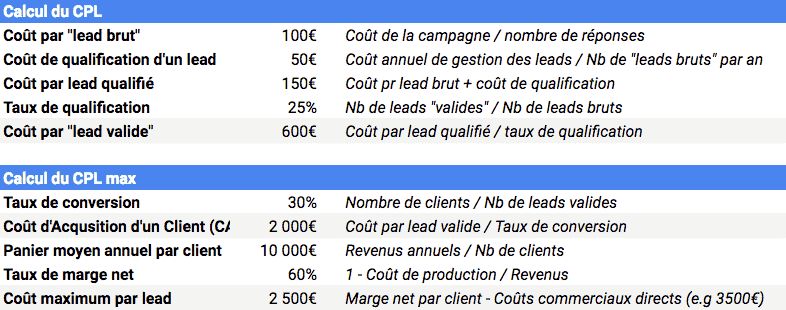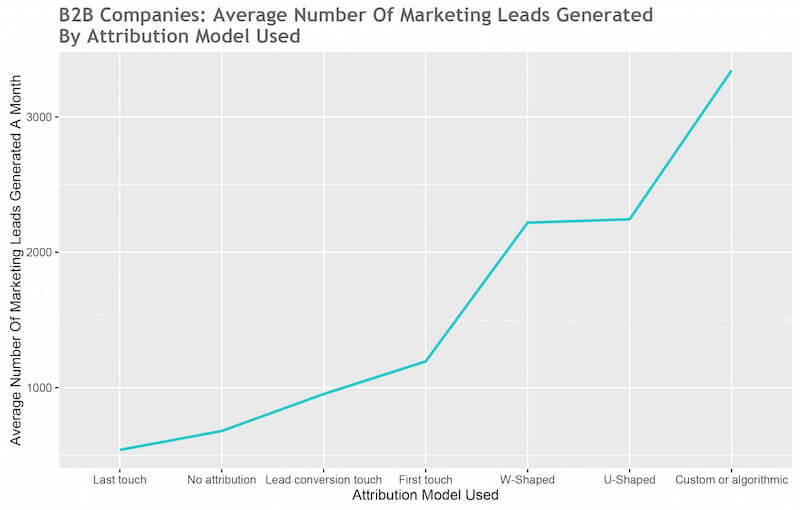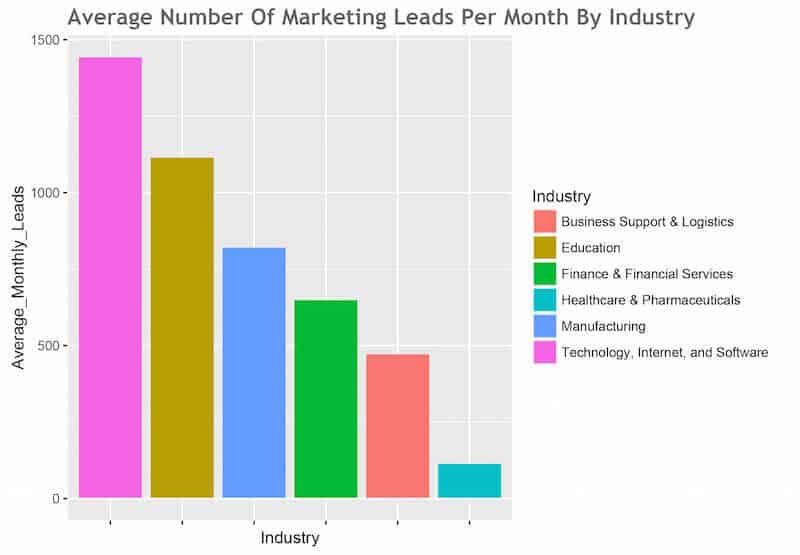The cost per lead (CPL) is an important KPI in marketing. It allows you to measure the effectiveness of your marketing investments. Whether you are buying a list, collecting names at trade shows or generating leads via inbound marketing techniques, identifying the cost per lead will help you spend your marketing budget more effectively.
The cost per lead formula is very simple:

Marketing expenditure includes the time invested by marketing teams, advertising expenditure, the cost of service providers, the cost of tools: in short, all the direct and indirect costs incurred in designing and implementing your campaigns.
A little advice from Salesdorado
Set up Google Analytics objectives to easily track the source of your leads (advertising, email, social networks…). This will allow you to calculate a CPL per source.
Knowing how much a lead costs you will allow you to make the right strategic decisions and better target your marketing spend (advertising, emailing, webinars…). We advise you to calculate the CPL for each channel in order to measure their respective performance and adjust your media mix. Significant differences in CPL between channels can be linked to differences in conversion. By definition, the higher the conversion rate, the lower the CPL – all other things being equal. From a strategic point of view, it makes sense to allocate maximum marketing budgets to the channels with the lowest CPL.
Sommaire
What is a “good” PLC?
Is a cost per lead of, say, 20 euros a “good” CPL, a “bad” CPL? It is actually very difficult to answer this question as it depends on several factors: the sector of activity, the type of campaigns, the degree of qualification of the lead and the value of the end customer. A very low CPL is often associated with low quality leads. And vice versa.
Raw, qualified or valid lead? From gross CPL to max CPL
We often speak of “leads” without any further clarification, as if the term had a univocal meaning, always identical to itself. In reality, there is a lead and a lead. A lead is a person who has shown an interest in an offer, and by extension the information provided by the person in question (email address, etc.). The intensity of the interest shown by the person and the volume of information collected determine the degree of qualification of the lead. The more qualified a lead is, the greater its value, and the more money can be invested to obtain it.
When setting up a B2B lead generation programme, the aim is to collect leads at a reasonable cost – leads that will then be passed on to the sales teams responsible for turning them into customers. An effective technique to determine in advance how much you can afford to spend on a lead is to calculate the maximum CPL of your campaign. Here is the methodology.
Let’s start by calculating the cost of the raw lead. A raw lead is a person who, for example, has simply sent an email requesting information. A raw lead, by definition, has not yet been the subject of any qualification work on your part. To calculate the gross CPL, you need to add up all the fixed and variable costs that can be directly linked to the campaign, and divide this by the number of expected responses (= number of gross leads). The tricky part is to really take all the costs into account. It is easy to overlook some of them. These costs include design and pre-production work, the cost of creating content, and the variable costs involved in developing and running the campaign.
Find out how to build a lead scoring strategy.
A raw lead, as such, is of little value. A raw lead is still a long way from becoming a customer. A lot of qualification work is needed. Let’s look at how to calculate the lead qualification cost. The formula for calculating this indicator is simple, as are most of the formulas presented in this article. It is calculated by dividing all expenses related to lead collection,lead management andlead nurturing by the number of gross leads managed. At this stage, it is more relevant to determine this indicator on an annual (or half-yearly) basis, rather than per campaign. This will be much simpler. If some of the lead nurturing work is outsourced, add the invoices of your service providers to your internal costs.
We now have two metrics at our disposal: the cost of a gross lead (or gross CPL) and the cost of qualifying a gross lead. From this you can calculate the cost of a qualified lead by adding the two metrics together.
Cost of a qualified lead = cost of a gross lead + qualification cost.
Once you have calculated the cost of a qualified lead, you should turn to the sales team and ask them some questions. Ask them about the average amount per order, which is calculated by dividing the total revenue by the number of orders. Ask them about the margin rate per order, and how much of the order is used to pay salespeople (= sales expenses / number of orders). From all this information you will be able to judge for yourself whether the cost of a qualified lead is reasonable or not. In particular, if the cost of a qualified lead is higher than the net margin, there is clearly a problem. The operation is not profitable: the company is losing money. You need to review some of the contours of your campaign (narrow the targeting, review the offer…).
To calculate a maximum cost per lead (= that does not jeopardise the profitability of the operation) you do not necessarily need to know how many responses will be collected, qualified and eventually converted. Instead, you need to know the cost per gross lead, the cost of qualification and the conversion rates of qualified leads into valid leads. You also need to know the net margin per order and the level of sales spend per order. This table summarises the process:

Let’s take a perfectly hypothetical example to flesh out the point. Let’s say you spend €15,000 and get 150 responses, i.e. 150 gross leads. Whatever the amount spent and the volume of responses obtained, by far the most important indicator is the cost per “gross lead”. In the table above, we have assumed a cost of 100 euros. We have also calculated a qualification cost of 50 euros, which gives us a cost per qualified lead of 150 euros.
The lead qualification process has resulted in a number of leads being lost: a number of people end up not being interested in the offer. In our example we assume a qualification rate of 25%. In other words, we have managed to qualify 25% of the initial gross leads. This allows us to calculate the cost of a “valid” lead (= a qualified lead): 600 euros (150 euros / 0.25).
From the information provided by sales, you know that the conversion rate of valid leads is 30%. The sales teams manage to convert 30% of the valid leads you send them into customers. From this we derive the customer acquisition cost (CAC): 2,000 euros (600 / 0.30). This customer acquisition cost should be compared to the maximum cost per lead of €2,500. The maximum cost per lead includes the net margin rate and the sales costs.
At first sight, the campaign looks promising: the customer acquisition cost is 500 euros less than the maximum cost per lead. We advise you to use a spreadsheet to fill in your different assumptions and calculate the profitability of your lead generation campaigns.
Which allocation model to calculate your CPL?
The aim is to minimise the cost per lead, to maximise the ROI of campaigns. As a marketer, you need to be able to track the number of leads you generate, with a good understanding of the length of sales cycles. This is much easier said than done. Bizible surveyed 370 B2B marketers, asking them how many leads they generate per month and what attribution model they use. The graph below shows the average number of leads generated per attribution model:

It can be seen that as the volume of leads increases, the more complex the attribution model used becomes. Customised or algorithmic attribution models generate the most leads. Conversely, when there is only a single point of contact, with no attribution model, the volume of leads is very low.
These results are quite logical. In their lead generation activities, marketers are confronted with an ever increasing amount of data. To cope with this, they are implementing increasingly complex attribution models to gain a more granular view of conversion data. The goal is to separate good campaigns from bad campaigns.
Bizible has produced a rather interesting table showing lead volumes by sector of activity:

Not surprisingly, there is a high volume of leads in the new technology, internet and software sector. In this sector, marketing investments are indeed very high: growth at all costs is the rule. The attribution models used in this sector are generally quite complex.
But does this mean that all companies, regardless of their sector, should opt for complex attribution models – because of the large volume of leads they can generate? The answer, by the study’s own admission, is not clear cut. The lower volume of leads observed in other sectors may also be related to the fact that they are often smaller entities that structurally cannot generate large volumes of leads.
However, one thing is clear: attribution models allow you to better manage your expenses and reduce the cost per lead by increasing the number of leads. They also allow you to make forecasts, to know quite precisely how many leads can be generated for X euros.
Check out our Top 10 email list cleaning tools.
With attribution models you can get a very accurate measure of the cost per lead per campaign and channel. Marketers usually use several channels for their campaigns. Calculating the CPL per campaign is very useful to identify the effective actions associated with the right channels. This is why attribution models are so important. With attribution models, you can calculate a CPL per campaign and per channel, but also identify the interaction points that generate the most sales. Ultimately, by reconstructing customer journeys, attribution models allow you to better understand the behaviour of your target, your prospects or customers. Having a limited knowledge of leads leads to build imprecise lead generation programmes and make it difficult to forecast growth.
In conclusion, we advise you to calculate the CPL and CPL max on the one hand, and to set up an effective attribution model on the other hand, in order to improve the performance of your lead generation campaigns and optimise them over time.






